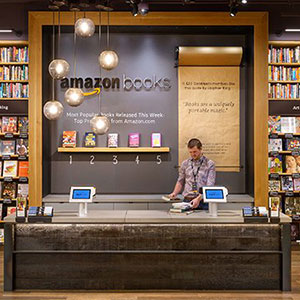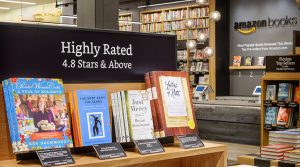
A few weeks ago, I was meeting a friend near the Empire State Building. With a little time to kill, I found myself in the new Amazon bookstore—officially known as Amazon Books. These new stores—so far there are 12 of them, with three more on the way—have gotten mixed reviews, and my review is mixed too. But it did offer some interesting insights about how e-tailers are trying to put a different spin on conventional retail.
The store’s layout is clean and heavy on wood. It didn’t feel generic like many Barnes & Noble stores do. But it also didn’t feel homey and personal like many independent bookstores, with their scattered shelves and omnipresent cats. And considering Amazon wants to turn these places into town squares, there was a surprising dearth of places to sit down.
The store is, however, packed with information. In fact, like the internet, it often felt like too much information. Every book had a card underneath featuring either a user review, a summary of its ranking on Amazon, or some other factoid. This is fun for a bit, but it gets a little overwhelming. (It might help if they used pictures.) It also more or less limits the selection to the most popular titles—discovering something off the beaten track is, for me, part of the fun of bookstores.

Reviews below the titles at Amazon Books
Another part of the store adapts one of Amazon’s prime sales techniques—“if you like this, then you’ll love…” That, again, is an interesting novelty, but the great thing about Amazon’s recommendations is they are personalized. These aren’t.
That said, incorporating information and customer reviews into in-store displays has become a growing trend in retail—Home Depot and Best Buy now regularly do it with, I would argue, more finesse than Amazon.
Could it work for a jeweler? Jewelry stores are known for their clean, elegant layouts. Yet, jewelry is also the ultimate blind item, and one reason customers still visit jewelry stores is to have their hands held through the process. So it’s possible that adding info, if done in the right way, might make the shopping trip more useful for some. If nothing else, it will be something different.

In general, though, Amazon Books showed me how typical brick-and-mortar expectations are hard to break. For instance, while you can pick up items at the store, the concept is clearly aimed at having you order things online. The same goes with Blue Nile’s webrooms. As a customer, that’s off-putting. When you go to a store, you expect to leave with something.
All in all, I found Amazon’s retail concept intriguing, but also uninspiring and sterile. I left thinking that no amount of algorithmically generated reviews can ever replace talking with a truly knowledgeable sales associate who loves books and can give you a heartfelt, personal recommendation.
Of course, that scenario is great when it happens. It rarely does anymore. Formats like Amazon Books only show promise when the standard retail experience is failing.
Related: How Bookstores Bounced Back
(Images courtesy of Amazon)
- Subscribe to the JCK News Daily
- Subscribe to the JCK Special Report
- Follow JCK on Instagram: @jckmagazine
- Follow JCK on X: @jckmagazine
- Follow JCK on Facebook: @jckmagazine